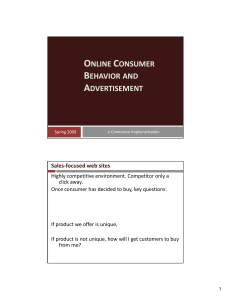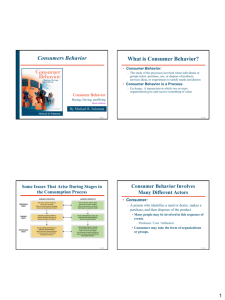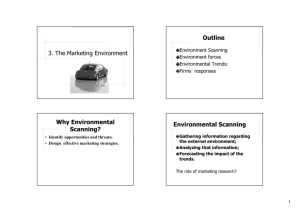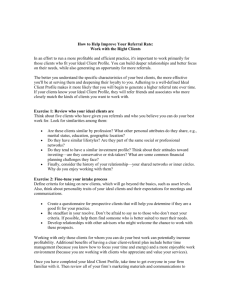PART ONE -- UNDERSTANDING MARKETING MANAGEMENT
advertisement
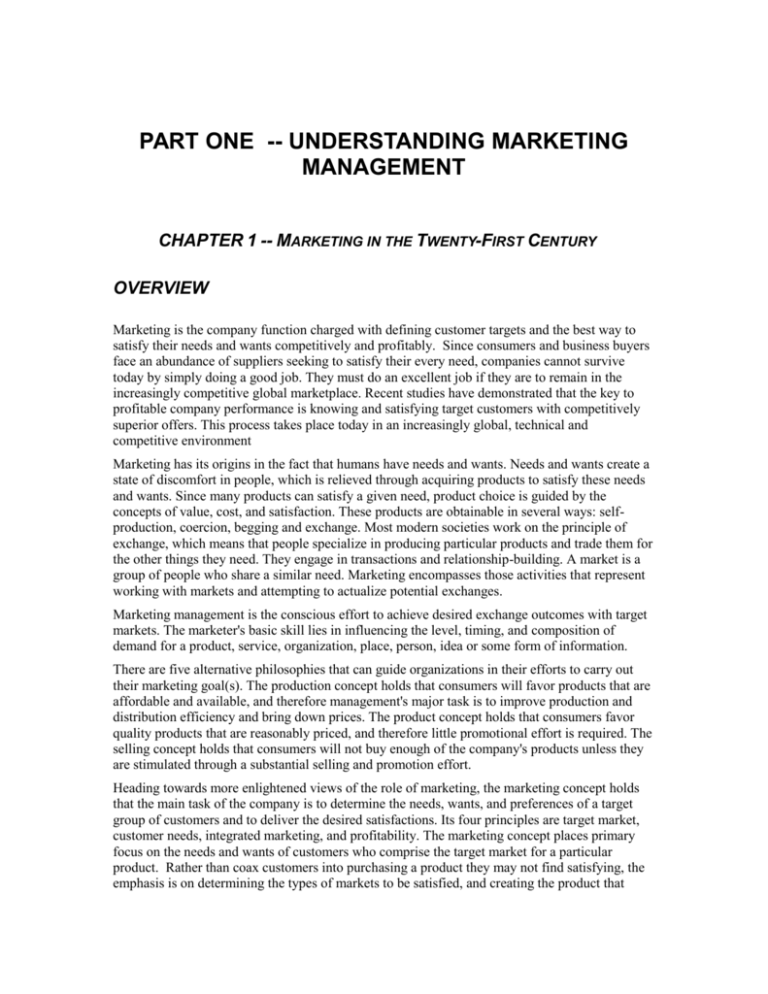
PART ONE -- UNDERSTANDING MARKETING MANAGEMENT CHAPTER 1 -- MARKETING IN THE TWENTY-FIRST CENTURY OVERVIEW Marketing is the company function charged with defining customer targets and the best way to satisfy their needs and wants competitively and profitably. Since consumers and business buyers face an abundance of suppliers seeking to satisfy their every need, companies cannot survive today by simply doing a good job. They must do an excellent job if they are to remain in the increasingly competitive global marketplace. Recent studies have demonstrated that the key to profitable company performance is knowing and satisfying target customers with competitively superior offers. This process takes place today in an increasingly global, technical and competitive environment Marketing has its origins in the fact that humans have needs and wants. Needs and wants create a state of discomfort in people, which is relieved through acquiring products to satisfy these needs and wants. Since many products can satisfy a given need, product choice is guided by the concepts of value, cost, and satisfaction. These products are obtainable in several ways: selfproduction, coercion, begging and exchange. Most modern societies work on the principle of exchange, which means that people specialize in producing particular products and trade them for the other things they need. They engage in transactions and relationship-building. A market is a group of people who share a similar need. Marketing encompasses those activities that represent working with markets and attempting to actualize potential exchanges. Marketing management is the conscious effort to achieve desired exchange outcomes with target markets. The marketer's basic skill lies in influencing the level, timing, and composition of demand for a product, service, organization, place, person, idea or some form of information. There are five alternative philosophies that can guide organizations in their efforts to carry out their marketing goal(s). The production concept holds that consumers will favor products that are affordable and available, and therefore management's major task is to improve production and distribution efficiency and bring down prices. The product concept holds that consumers favor quality products that are reasonably priced, and therefore little promotional effort is required. The selling concept holds that consumers will not buy enough of the company's products unless they are stimulated through a substantial selling and promotion effort. Heading towards more enlightened views of the role of marketing, the marketing concept holds that the main task of the company is to determine the needs, wants, and preferences of a target group of customers and to deliver the desired satisfactions. Its four principles are target market, customer needs, integrated marketing, and profitability. The marketing concept places primary focus on the needs and wants of customers who comprise the target market for a particular product. Rather than coax customers into purchasing a product they may not find satisfying, the emphasis is on determining the types of markets to be satisfied, and creating the product that achieves this satisfaction objective. Choosing target markets and identifying customer needs is no small task; a marketer must dig beyond a customer’s stated needs. Once this is accomplished, a marketer can offer for sale the products that will lead to the highest satisfaction. This encourages customer retention and profit, which is best achieved when all areas/departments of a company become “customer-focused”. Moving beyond the marketing concept, the societal marketing concept holds that the main task of the company is to generate customer satisfaction and long-run consumer and societal well-being as the key to satisfying organizational goals and responsibilities. Interest in marketing is intensifying as more organizations in the business sector, the nonprofit sector, and the global sector recognize how marketing contributes to improved performance in the marketplace. The result is that marketers are re-evaluating various marketing concepts and tools focus on relationships, databases, communications and channels of distribution, as well as marketing outside and inside the organization. LEARNING OBJECTIVES: After reading this chapter students should: Know why marketing is important to contemporary organizations Understand the core concepts of marketing Know the basic tasks performed by marketing organizations and managers Understand the differences between the various orientations to the marketplace Know the components of the marketing concept and why they are critical to successful marketing practice Know why marketing has been found to be critical to different types of organizations and in different environments. CHAPTER OUTLINE: I. II. Introduction --- Importance of Marketing in Contemporary Organizations - with rapid changes come both challenges and opportunities, marketing allows organizations to take advantage of these opportunities Marketing Tasks A. Scope of Marketing -- Involves a broadened View of Marketing - to types of entities (goods, services, and ideas) 1. Products are anything offered for sale or exchange that satisfies a need or want. 2. Products can be goods, services, ideas -- and also people, places, activities, organizations and information. B. A Broadened View of Marketing Tasks - Decisions Marketers Make 1. Consumer Markets and Business Markets - Each requires new tools and capabilities to better understand and respond to the customer. 2. III. Global Markets, Nonprofit and Governmental Markets - Becoming more sophisticated in recognizing and dealing with marketing challenges and decisions. Marketing Concepts and Tools A. Defining Marketing 1. Marketing Defined - a social and managerial process by which individuals and groups obtain what they need and want through creating, offering, and exchanging products of value with others. B. Core Marketing Concepts 1. Target Markets and Segmentation - Every product or service contains features which a marketer must translate into benefits for a target market. It is these benefits the consumer perceives to be available in a product and directly impacts the perceived ability to meet the consumer need(s) or want(s). 2. Marketers and Prospects - a marketer is someone actively seeking one or more prospects for an exchange of values. A prospect has been identified as willing and able to engage in the exchange. 3. Needs, Wants, and Demands - to need is to be in a state of felt deprivation of some basic satisfaction. Wants are desires for specific satisfiers of needs. Demands are wants for specific products that are backed by an ability and willingness to buy them. 4. Product or offering - Anything offered for sale that satisfies a need or want. Products consist of three primary components: goods, services and ideas. The physical product provides the desired service or action. 5. Value and Satisfaction - Value is the consumer’s estimate of the product’s overall capacity to satisfy his or her needs determined according to the lowest possible cost of acquisition, ownership and use. 6. Exchange and Transactions - exchange means obtaining a desired product by offering something desirable in return. Five conditions must be satisfied (p.11) A transaction is the trade of values (involves several dimensions). 7. Relationships and Networks - Relationship marketing seeks long-term, “win-win” transactions between marketers and key parties (suppliers, customers, distributors) The ultimate outcome of relationship marketing is a unique company asset called a marketing network of mutually profitable business relationships. 8. Marketing Channels - Reaching the target market is critical. To do this the marketer can use two-way communication channels (medianewspapers through the Internet), versus more traditional means. The marketer also must decide on the distribution channel, trade channels and selling channels (to effect transactions). 9. Supply chain - the long channel process that reaches from the raw materials and components to the final product / buyers. Perceived as a value delivery system. 10. Competition - Includes actual and potential rival offerings and substitutes. A broad view of competition assists the marketer to IV. V. recognize the levels of competition, based on substitutability: brand, industry, form and generic. 11. Marketing Environment - Includes the task (immediate actors in the production, distribution and promotional environments) and the broad environments (demographic, economic, natural, technological, politicallegal and social-cultural). 12. Marketing Mix - the set of marketing tools the firm uses to pursue marketing objectives with the target market. Involves recognition and use of the four Ps and the four Cs in the short run and the long run. Company Orientations Toward the Marketplace A. The Production Concept - Assumes consumers will favor those products that are widely available and low in cost. B. The Product Concept - Assumes consumers will favor those products that offer the best combination of quality, performance, or innovative features. C. The Selling Concept - Assumes organizations must undertake aggressive selling and promotion efforts to enact exchanges with otherwise passive consumers. D. The Marketing Concept _- Assumes: 1. The key to achieving organizational goals consists of being more effective than competitors in integrating marketing activities toward determining and satisfying the needs and wants of target markets. 2. Target Market - no company can operate in every market and satisfy every need. 3. Customer Needs - it’s not enough to just find the market; marketers must also understand their customer's needs and wants. This is not a simple task. 4. Integrated Marketing - all of a company’s departments must work together to serve the customer’s interests. This begins among the various marketing functions and carries out into other departments. 5. Profitability - the ultimate purpose of marketing is to help organizations achieve profitability goals. 6. Hurdles to Adopting a Marketing Concept a) Organized Resistance - some departments see marketing as a threat to their power in the organization b) Slow Learning - despite efforts by management, learning comes slow c) Fast Forgetting - there is a strong tendency to forget marketing principles 7. Profitability E. The Societal Marketing Concept 1. Societal Marketing Concept - the organization’s task is to determine the needs, wants, and interests of target markets and to deliver the desired satisfactions more effectively and efficiently than competitors in a way that preserves or enhances the consumer’s and the society’s well-being. How Business and Marketing are Changing A. Company Responses and Adjustments - the focus here is on reengineering the firm, outsourcing goods and services, e-commerce, benchmarking, alliances VI. (networking), partner-suppliers, market-centered (versus product centered), local and global marketing (versus only local), and decentralization to encourage innovative thinking and marketing. B. Marketer Responses and Adjustments - Focus on relationship marketing (versus transactional marketing), creation of customer lifetime value orientation, focus on customer share marketing versus only market share, target marketing (versus mass marketing), individualization of marketing messages and offerings, customer databases for data-mining, integrated marketing communications for consistent images, consideration of channel members as partners, recognition of every employee as a marketer, and model and fact-based decision making versus intuition alone. Summary MARKETING AND ADVERTISING 1. The Air Canada ad in Figure 1 stresses the time-saving aspect of its flights between the United States and Canada as well as the frequent flier mileage benefits. How do these two elements affect the ratio of benefits to cost in the value equation? Other than advertising lower ticket prices, how else can Air Canada use its advertising to affect the value perceived by customers? Suggest at least two specific value-enhancing approaches Air Canada might take. Answer: By reducing the amount of time needed to fly between the United States and Canada, Air Canada lowers the total costs in the denominator of the value equation, which raises the value ratio. In addition, the frequent flyer benefits add to the numerator of the value equation, again raising the value ratio. Two other ways Air Canada can use its advertising to affect the value perceived by customers are: (1) invite travelers to use specially-equipped Air Canada waiting lounges with office amenities such as e-mail access and fax machines, which boosts the benefits; and (2) invite customers to sign up for a special service that automatically notifies up to three relatives and/or business associates when a customer's plane arrives at its destination, which cuts the psychic costs and adds to the emotional benefits. Students may offer other value-enhancing ideas. 2. The marketing network of Dow Chemical Company consists of a wide range of stakeholders, including customers, employees, suppliers, distributors, and volunteers and beneficiaries of nonprofit organizations such as Habitat for Humanity. Why would Dow advertise its support of Habitat for Humanity? What effect does the company expect this ad to have on its relationships with various stakeholders? How can Dow build on strong stakeholder relationships to compete more effectively in the construction industry? Answer: Dow advertises its support of Habitat for Humanity because it believes in the societal marketing concept. Some students may argue that Dow is also enhancing the emotional benefits that customers perceive in its products and enhancing its relationship marketing by creating a stronger social tie with customers and other stakeholders. In addition, Dow is putting a more human face on its corporation and products. Dow expects this ad to encourage customers (both consumers and businesses), suppliers, and other global stakeholders to choose and support Dow products because the company is conscientiously balancing profitability and customer satisfaction with concern for society's well-being. Dow can build on strong stakeholder relationships to compete more effectively in the construction industry in various ways. One suggestion: create specialized programs to attract and retain construction customers that are particularly interested in supporting social causes such as Habitat for Humanity. Another suggestion: expand this type of program to include the wholesale and retail companies that carry Dow products, which strengthens channel relationships and motivates channel members to do an even better job of selling Dow construction products. Students are likely to offer other creative ideas. FOCUS ON TECHNOLOGY Charles Schwab, based in San Francisco, is a giant discount brokerage firm offering a wide range of investment and financial services options. When someone visits a Schwab office or calls the company, employees can immediately bring up that customer's online records and talk knowledgeably about investments and services suited to that customer's individual situation. Schwab also invites customers to open accounts, locate financial research, place trades, and track market trends on its Web site. Browse the Schwab Web site (www.schwab.com), looking at the offerings and the online demonstration of Schwab capabilities. How does this Web site confirm Schwab's focus on the customer? Why is employee access to complete and current customer records especially important in the brokerage business? What other parts of Schwab must be properly coordinated to ensure integrated marketing for customer satisfaction? Answer: The Schwab Web site can be customized to fit each customer's interests; it also offers a wide range of information, resources, and tools to help customers address their financial needs. In this way, Schwab confirms its focus on the customer. Brokerage employees need access to complete and current customer records because securities trading requires speedy response. Outdated or incomplete information can cost customers money and aggravation—making customers angry and ultimately driving them away. Other parts of Schwab that must be coordinated to ensure integrated marketing for customer satisfaction are: external marketing, with the marketing mix accurately reflecting Schwab's features and benefits; internal marketing, with all employees trained and motivated to provide excellent customer service; all layers of management, ready to assist the front-line people who handle customer transactions and customer service; and all company departments ready to work together to respond to and satisfy Schwab's customers. MARKETING FOR THE MILLENNIUM E-commerce is growing exponentially because of its convenience, savings, selection, personalization, and information. Still, figuring out exactly how to reach the right cybercustomers can be challenging for even the largest marketers. Kraft, Kellogg, and other companies are learning to use targeted banner advertising to reach the customer segments most likely to be interested in their products. These companies boosted online sales significantly by placing banner ads on Peapod, a Internet-based grocery shopping service. Untargeted ad banners, by comparison, are inexpensive but draw less customer response. Visit Peapod's Web site (www.peapod.com) and type in your zip code, as directed. Then sign in to take the shopping demonstration showing which products are offered and how the service operates. What types of products could potentially benefit from advertising on this site? What kind of information would these marketers want from Peapod in order to determine the value of targeted banner advertising on this site? How might Kellogg use banner advertising on Peapod to support a new cereal product? To support an existing cereal product? Answer: Branded grocery products in particular can potentially benefit from advertising on Peapod's Web site—as long as online customers can purchase these products from Peapod. This Web advertising would reinforce the messages of other marketing communications such as broadcast commercials and print ads, building consumer demand and preference for the branded products. In addition, grocery products that represent impulse purchases (such as snacks) would benefit from advertising on Peapod, because consumers can make an immediate purchase to satisfy the wants generated by these ads. Marketers would want to know how many consumers view Peapod's ads; how many consumers have responded (if this information is available) to previous ads; how many other products in the marketer's category are advertising at the same time on Peapod banners (to gauge competition); how long the banner will run; and how fees will be calculated (according to number of clicks, number of times page is accessed, or other method?). Students may suggest other questions, as well. Kellogg can use banner advertising on Peapod to support a new cereal product by starting with a banner that highlights the new cereal's main feature and benefit while clearly identifying the target audience ("Try Cereal X, a good tasting, low-sugar cereal for children," for example). It can also use the banner to remind consumers when to watch for the new product on Peapod's listings; when to watch for commercials and print ads promoting the new product; when to check for special new-product pricing. Kellogg can use banner advertising on Peapod to support an existing cereal product by reinforcing the name and main feature/benefit ("Special K has all essential vitamins for healthy bodies," for example), reminding consumers to watch for the product's advertising in other media ("See ad in this week's newspaper"), urging consumers to stock up during price specials, and so on. Students will have other creative ideas for ways that Kellogg can use banner advertising on Peapod.


